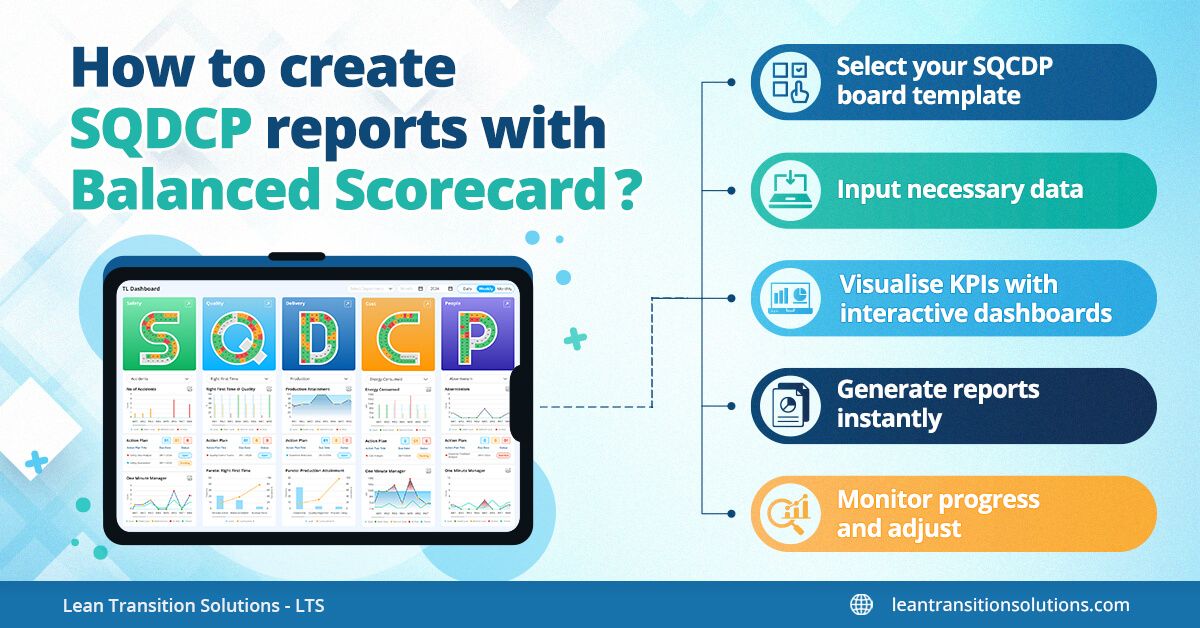What’s the best way to generate SQCDP reports using digital boards?
1. Select your SQCDP board template
Begin with selecting the appropriate digital SQDCP board template that fits your operational needs. Choosing a digital SQDCP board is the best action. Select the digital platforms that provide a variety of templates that can be easily customised. Make sure that it can track all relevant metrics for specific report making.
Once you have set up your board, start filling it with relevant data. Whether you are tracking production progress, employee engagement, or operational costs, your SQCDP board should reflect real-time information.
Define key metrics for your SQCD report
→ Safety (S) – Number of incidents, near-misses, compliance with safety protocols.
→ Quality (Q) – Defect rates, customer complaints, adherence to quality standards.
→ Cost (C) – Production costs, budget variance, cost-saving initiatives.
→ Delivery (D) – On-time delivery rates, production cycle time, order fulfillment.
→ People (P) – Employee engagement, absenteeism, training completion rates.
3. Visualise KPIs with interactive dashboards
Use viusalisation tools to convert your SQCDP boards into dynamic dashboards. It can take all KPIs and render them into visual formats like bar charts, pie charts, or trend lines, making data actionable and interpretable.
4. Generate reports instantly
You can automatically generate SQDC reports in formats that are suitable for you, such as a PowerPoint to present commercially or a deep PDF report to review internally. Reporting thus becomes much faster and more consistent.
5. Monitor progress and adjust
Once your SQCDP report is generated, use it to evaluate performance and spot areas for improvement. The interactive feature of digital boards allows you to change the parameters in real time, making it easier to hone strategies and track progress over time.
Why is an SQCDP report crucial for your business?
- Make the team equipped with relevant information that allows them to make strategic decisions.
- Recognise emerging opportunities that contribute to marketing advantages.
- Make performance better by identifying bottlenecks and areas for improvement.
- Focus on quick delivery time, quality, and service that build customer loyalty.
- Provide corrective actions results in cost-effective solutions and enhances revenue.
Are you still using outdated methods to analyse your SQCDP performance? Without the right tools to track and analyse these metrics in real time the full potential of SQCDP reports remains untapped. Try digital SQDCP board of Data Point Balanced Scorecard and transform your operations with automated, data-driven reports. The software integrates seamlessly with your existing data systems, ensuring that your reports are continuously updated, automatically generated, and ready for action when you need them.
Here’s how Data Point’s SQDCP solutions improves your operational excellence:
- Automated Data Collection – Eliminates manual input errors and saves time.
- Real-Time Performance Tracking – Ensures accurate and up-to-date reporting.
- Customisable Dashboards – Allows teams to tailor views to specific needs.
- Integration with ERP & MES Systems – Connects performance tracking with broader operational data.
- Daily Huddle Board Functionality – Supports team discussions and quick decision-making.
Want Smarter, Faster Reporting?
